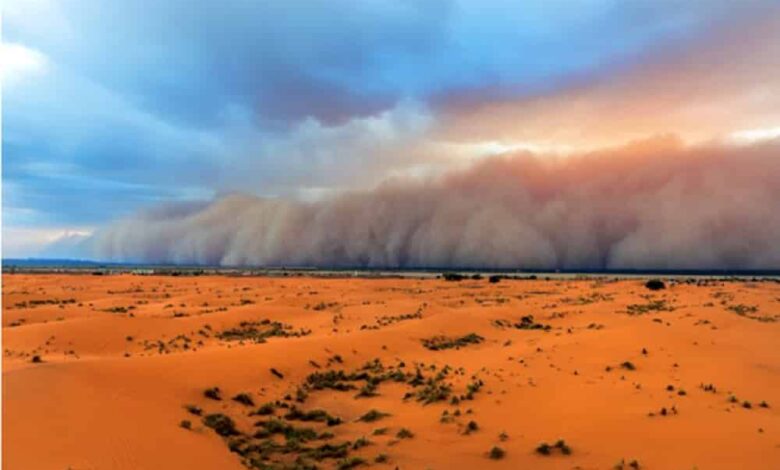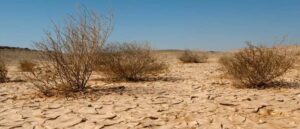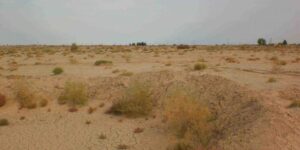The Danger of Moving Sand Dunes in Iran

iran-environment-desert
Written by
Khalil Khani
Deserts cover 907,293 km2 of Iran’s landscape. Sand dune fields are scattered across the arid and semiarid areas of Iran. Sand dune movement causes severe damage to infrastructure and rural settlements every year. Identifying active dunes and monitoring areas with migrating sand are important prerequisites for mitigating these damages. These arid expanses, characterized by towering sand dunes and extreme temperatures, have captivated the imagination of explorers and travelers for centuries. Yet, beneath the stunning beauty of these shifting sands lies a multifaceted and often underestimated threat; moving sand dunes.
Most of the sand dunes exist in and around the Dasht-e-Kavir and Lut deserts in Iran. Dasht-e Kavir desert is mostly uninhabited and it is the largest desert in the north-central region, predominantly characterized by crusty salt ridges and salty marshlands. Iran, with its diverse landscapes and rich natural beauty, is home to some of the world’s most stunning deserts. These ever-shifting masses of sand may appear benign, even enchanting, but they pose a significant threat to both the environment and the people living in their vicinity. This article offers an in-depth examination of the dangers posed by these dynamic desert formations the danger of moving sand dunes, and the consequences they bring.
The Deserts Dynamic:
Iran’s deserts are geological wonders, shaped by millions of years of wind and water erosion activities. They feature towering dunes that rise like mountains, their silhouettes shifting under the relentless force of nature. These deserts span vast regions of the country, covering approximately one-fifth of the total land area. Iran’s most vast deserts are Dasht-e Kavir (Great Salt Desert) and Dasht-e Lut (Lut Desert). The Lut desert in southeastern Iran is surrounded by mountains, which affect the formation and morphology of the Yalan (Lut) sand sea. It is the largest sand sea in the country, formed by multidirectional winds and special topography.

iran-environment-irgc-desertation
The Jazmorian sand sea, the second vast sand sea in the country, extends along the north and south of the Jazmorian ephemeral Salt Lake. It features dunes in two parts: one part located south of the ephemeral lake between Iranshahr and Qalaeh Ganj in the Sistan and Baluchistan province, and a smaller part northwest of the desiccated lake, called the Rudbar dune field in the Kerman province. The Sistan sand dunes originate from the Hamouns ephemeral lakes in Iran and extend to the Registan sand sea in southern Afghanistan and are strongly influenced by the 120-day wind.
Other dune areas include the Khuzestan sand sea, also known as the Karkheh sand sea, extending from Iraq into the Ilam and Khuzestan provinces, as well as coastal dunes formed near the Persian Gulf and the Oman Sea beaches between the southern Iranian cities of Chahbahar and Bushehr. These deserts are characterized by their arid landscapes, scorching temperatures, and immense sand dunes. While these dunes have fascinated researchers and explorers for centuries, they are far from static.
Sand movement and following desertification is a complex process involving several types of sand grain movement that occur more or less simultaneously. Dune growth and movement are the result of sand flow on and around a dune during periods when the wind is strong enough to move sand. Aeolian dunes are constantly changing shape in response to changes in wind velocity or direction of wind. Their extension is greater, when sand drifts from surrounding areas are more than downwind drifts. Sand seas (Erg) are one of the most significant features created by wind deposition and are broad, flat areas of desert covered with wind-swept sand with little or no vegetative cover. Sand dunes within sand seas can change in distribution, extent, size (length or height), or form depending on wind direction and strength. The formation, activity, and stability of sand seas are closely related to climatic conditions, and dunes may be reactivated or stabilized as conditions change.
The Perils of Moving Sand Dunes and its Environmental Impact:

iran-environment-desert2
Moving sand dunes can wreak havoc on the fragile desert ecosystem as it destroys habitats. As they advance, they bury plant life and obliterate habitats for a variety of species, threatening biodiversity. The continuous movement of sand dunes destabilizes the soil, leading to increased soil erosion. This process exacerbates desertification, rendering once-fertile land, barren.
Climatic factors, wind and water erosion, population pressure, over-exploitation of water resources, and over-grazing have been identified as the main reasons for desertification in Iran. Sand dune activity is defined as changes in migration rates and/or variations in the amount of sand shifting on the dune itself. Moving sand dunes can have devastating effects on the local ecosystem. As they shift, they bury and destroy plant life, making it nearly impossible for vegetation to grow in their path. This not only depletes the fragile desert ecosystem but also exacerbates soil erosion and dust storms, further harming the environment.
One of the environmental problems in the arid and desert areas of the world that operate externally is wind erosion and its consequences, such as dust storms and the displacement of massive masses of sand. Dust storms destroy lands, reduce visibility, dust concentrations in some cases reach 6 g/m3, and cause the spread of radioactive materials. The Greenhouse Effect leads to the transport of salt and chemical substances (herbicides) to the atmosphere and increases respiratory problems.
A survey by the Iranian Forest, Rangeland, and Watershed Management Organization (FRWO, 2004) reported that wind erosion causes annual damages of more than $18.3 billion. Therefore, the stabilization of sand dunes has been a major objective of programs to combat desertification during the past half-century. The main method of dune stabilization in Iran is a combination of oil mulch spraying and tree plantation.
This method, as a common technique for sand dune stabilization, was used first on the Khuzestan sand dunes in 1958 and then on the Sabzevar dune fields in 1965. Oil mulch, which is a hydrocarbon colloid extracted from petroleum, stabilizes shifting sands, preserves soil moisture, and assists in establishing vegetation cover. However, Studies show that the responsible authorities used this technique without paying any attention to the results or the already-known devastating environmental effects of their mulching operations on the indigenous flora and fauna or on the wider regional ecosystem, particularly concerning regeneration and the damage to the region’s soil.
Threat to Infrastructure:
Eolian process or wind erosion is a natural risk in arid regions, since not only destroys the soil texture, and makes facial morphological changes, but also soft quicksand movement and their accumulation in farmlands. Residual-moved sediment particles constantly damage human beings. Dunes dynamically make quicksands to damage farmlands, local dwellings, transportation, communication infrastructures, and roads annually and destroy them. Human settlements near moving sand dunes are at constant risk. These dunes can advance at an astonishing rate, engulfing roads, homes, and even entire villages. The financial burden of rebuilding infrastructures can be crippling, and it often disrupts the lives of those affected.
Water Scarcity:

iran desertification (1)
Sand dunes are a significant sign of desert regions, which are occupying a massive extension of desert areas in Iran. The movement of sand dunes can also disrupt water sources. Rain does fall occasionally in deserts, and desert storms are often violent. A record 44 millimeters of rain once fell within 3 hours in the Sahara. Large Saharan storms may deliver up to 1 millimeter per minute. Normally dry stream channels, called arroyos or wadis, can quickly fill after heavy rains, and flash floods make these channels dangerous. More people drown in deserts than die of thirst.
Many desert communities rely on underground aquifers for their water supply. Qanat is the main water source of arid regions of Iran. A Qanat is a kind of subterranean horizontal tunnel and is usually excavated in soft sediments. It conducts groundwater to the surface at its emerging point. In addition to the tunnel, each qanat contains anywhere from several to hundreds of vertical wells for removal of dig materials and ventilation of the tunnel. However, the moving sand dunes place these vital water resources under serious risk.
The vitality of natural ecosystems in arid and semiarid regions greatly depends on water availability, as they are highly sensitive to changes in precipitation and potential evapotranspiration, as well as to land management practices. When sand dunes advance, they can block or contaminate these water sources, leading to severe water scarcity issues for local populations.
Dust and Air Quality:
Sand and dust storms are meteorological phenomena that are triggered due to turbulent wind enabling to removal of loose sand and dust from exposed dry topsoil in arid and semi-arid areas, causing movement of sand dunes or airborne dust. Sand and dust storms have major and multiple economic, health, and environmental impacts causing respiratory infections and diseases. As sand dunes shift, they release vast quantities of fine dust particles into the atmosphere. This dust can travel great distances, affecting air quality in neighboring regions and even beyond Iran’s borders. Poor air quality poses health risks and can lead to respiratory problems for residents.
Cultural and Historical Losses:
Communities residing near moving sand dunes face constant peril. The rapid advancement of these dunes can engulf roads, homes, and entire villages. Rebuilding infrastructure can be financially crippling and disrupt the lives of those affected. Iran’s deserts are not only ecologically significant but also culturally and historically important. Ancient archaeological sites, petroglyphs, and other cultural treasures are often found in desert areas. The movement of sand dunes can obscure or destroy these invaluable cultural heritage sites. The livelihoods of many desert communities are deeply intertwined with their environment. The disruption caused by moving sand dunes can threaten traditional practices like agriculture and livestock herding.
Efforts to Mitigate the Dangers:

Recognizing the dangers posed by moving sand dunes, man has long undertaken various measures to address these issues for decades. However, even though Iran is one of the pioneers in this field, the progress has been slow and selective, not scientific and not systematic.
Desertification-750×375-1
Afforestation Programs: Iran has initiated afforestation programs in desert areas to stabilize sand dunes and prevent their movement. Planting drought-resistant vegetation helps anchor the sand and mitigate the environmental impact. Various drought-tolerant species such as Haloxylon persicum, H. aphyllum, Calligonum polygonoides, Tamarix ssp., Atriplex canescens, and others have been used.
Engineering Solutions: Engineers have constructed barriers and windbreaks to halt the advance of sand dunes toward populated areas and vital infrastructure.
Early Warning Systems: Improved monitoring and early warning systems can provide local communities with the necessary information to prepare for sand dune encroachment, reducing the potential for loss of life and property.
International Collaboration: Iran has engaged long in international collaborations to share knowledge and expertise on desert management and sand dune stabilization. However, even though the ruling clerics talk and propose significant ideas they channel sand dunes establishment funds somewhere else.
Conclusion
While the moving sand dunes of Iran are undoubtedly captivating and enigmatic, their dangers cannot be underestimated. These dynamic desert features threaten the environment, infrastructure, and livelihoods of those living in their shadows. The stabilization of dunes has been a major objective of anti-desertification programs over the past half-century in Iran. Accordingly, the identification of areas with active dunes is of paramount importance in prioritizing the monitoring and stabilization efforts. However, through concerted efforts in afforestation, engineering solutions, and international collaboration, Iran hasn’t taken serious steps to mitigate the risks associated with these ever-shifting sands. The preservation of Iran’s unique deserts and the well-being of its desert communities depend on ongoing efforts to confront the danger of moving sand dunes.
* Khalil Khani is an Environmental Specialist and a Human Rights activist. He holds a Ph.D. in Ecology, Botany, and Environmental Studies from Germany and has taught at the University of Tehran and the Hesse State University in Germany. He is also a Doctor of Medical Psychology from the United States.

